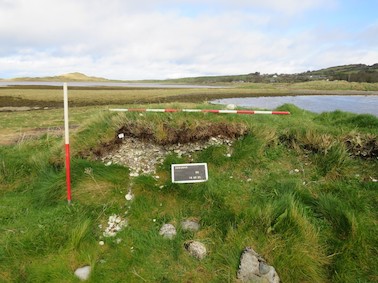County: Sligo Site name: Culleenamore
Sites and Monuments Record No.: SL013-117 Licence number: 22E0643
Author: Alan Healy and Rory Connolly
Site type: Midden
Period/Dating: N/A
ITM: E 560921m, N 833926m
Latitude, Longitude (decimal degrees): 54.252678, -8.599685
SL013-117 (Site D) was sampled as part of a wider research project, Neolithic Marine Resource Exploitation in Atlantic Europe (NeoMarE), which is funded by an Irish Research Council Government of Ireland Postdoctoral Fellowship (GOIPD/2021/228) under the direction of Dr Rory Connolly and Dr Jessica Smyth, based at the School of Archaeology, University College Dublin, and Site Director Alan Healy of Archaeological Management Solutions (AMS). The project seeks to investigate a series of six coastal shell middens in County Sligo with the objective of assessing both timing and duration of midden deposition. The work aims to progress our understanding of past human occupation in Sligo’s coastal zone and establish how these sites relate to the wider archaeological landscape.
All of the sites included in the project are exposed in section and remain extremely vulnerable to substantial loss in the event of significant storm activity. Active erosion of archaeological material from the section faces is evident at each of the sites. The works carried out will mitigate against the loss of archaeological information to coastal erosion and accelerating climate change impacts.
SL013-117 consists of midden material exposed and eroding in various places within a low grass-covered mound (diam. c. 8-9m; H 1.6-1.6m). It is unclear whether these represent discreet deposits, or a single continuous midden exposed at multiple locations through erosion, though the latter seems probable. Oyster (Ostrea sp.) shells predominate but limpet (Patella sp.) shells are also present in small quantities. Bone and charcoal can also be sporadically seen mixed throughout. The perimeter of midden (SL013-117) at Culleenamore is continually subjected to the erosive forces of wave action. This process is actively leading to the dislodgment and loss of archaeological deposits. The lateral extent of the midden is substantial, but it thins out abruptly outside of the central grass-covered mound. This would seem to imply that a significant portion of material has already been lost to erosion at some time in the past.
The archaeological works at the site involved recording the exposed sections and collecting samples for radiocarbon dating. In total, seven samples containing shell and some bone were collected.

Strokestown, Co Roscommon